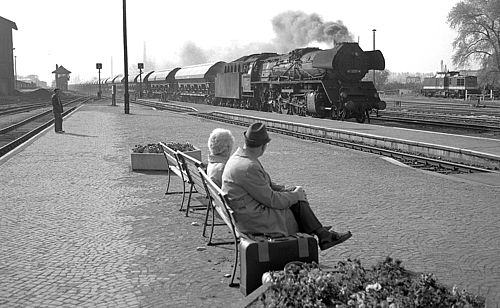Trains, Locomotives and People

Foto: Burkhard Wollny
Burkhard Wollny is a photographer and train fan from near Stuttgart. He is especially keen on old steam locomotives. Before the fall of the Berlin wall, he repeatedly traveled to the GDR and to West Berlin where many of the old locomotives were still in service. This resulted in unique pictures of life in towns, in the provinces, at stations and on the railway lines.
Traveling by train was part of everyday life in the GDR. While West Germany became a car nation after the Second World War, East Germany remained largely faithful to its railways. Around 1980, 40 percent of passenger journeys were still made by train. From today’s perspective, that sounds like a progressive traffic concept but 40 years ago, it was considered backward. Small stations, crowded commuter trains and a wide network of branch lines took people to the farthest reaches of the workers’ and peasants’ state.
Good-humored passengers in the Ore Mountains. The Saxon IV K rebuilt locomotive seen here runs today on the Preßnitztal line reopened after 1990.
Foto: Burkhard Wollny
An oil-fired rebuilt engine (class 50.35) passing the Prenzlauer Allee S-Bahn station heading towards the Dunckerstraße underpass.
Passengers and passers-by at the railway station Steinbach of the Wolkenstein – Jöhstadt narrow gauge line which was gradually closed from 1982 onwards. After reunification, the line was reopened as a private museum railway.
Foto: Burkhard Wollny
Everyday Life beside Tracks and at Stations
In 1975, Wollny applied for the “temporary ID card” for residents of West Berlin. According to the Berlin Agreement of 1971, this meant it was relatively easy for him to obtain entry visas for the GDR. He felt the pull of the Ore Mountains and the hills of Thuringia and traveled there extensively. Thanks to his unconventional, open nature, he easily came into contact with people and was able to photograph undisturbed. For example, besides the ever-present steam locomotives, Wollny also succeeded in capturing rare insights into everyday life at stations and beside the tracks. The selected photographs range from nostalgic railway romanticism to everyday life in a country that was desperately trying to keep pace with modernity, but in many cases was stuck in backwardness due to economic deficiencies and scarcity of resources.
The Photographer
Burkhard Wollny was born in Freiburg im Breisgau in 1950 and grew up in Stuttgart. At the age of ten, he frequently used to visit the railway depot in Stuttgart with his grandfather. There he began to photograph the locomotives and trains with his small Kodak Instamatic. Later he was given a Praktica single-lens reflex camera as a present with which many of the photos in the exhibition were taken. Wollny became a successful banker and management consultant while devoting a large part of his leisure time to his passion for railway photography. He upgraded his photographic equipment to a professional standard and developed his own films. Over the years, a huge archive totaling 100,000 black-and-white photos and 96,000 slides was created featuring many different railways, locomotives, trains and railway systems.
